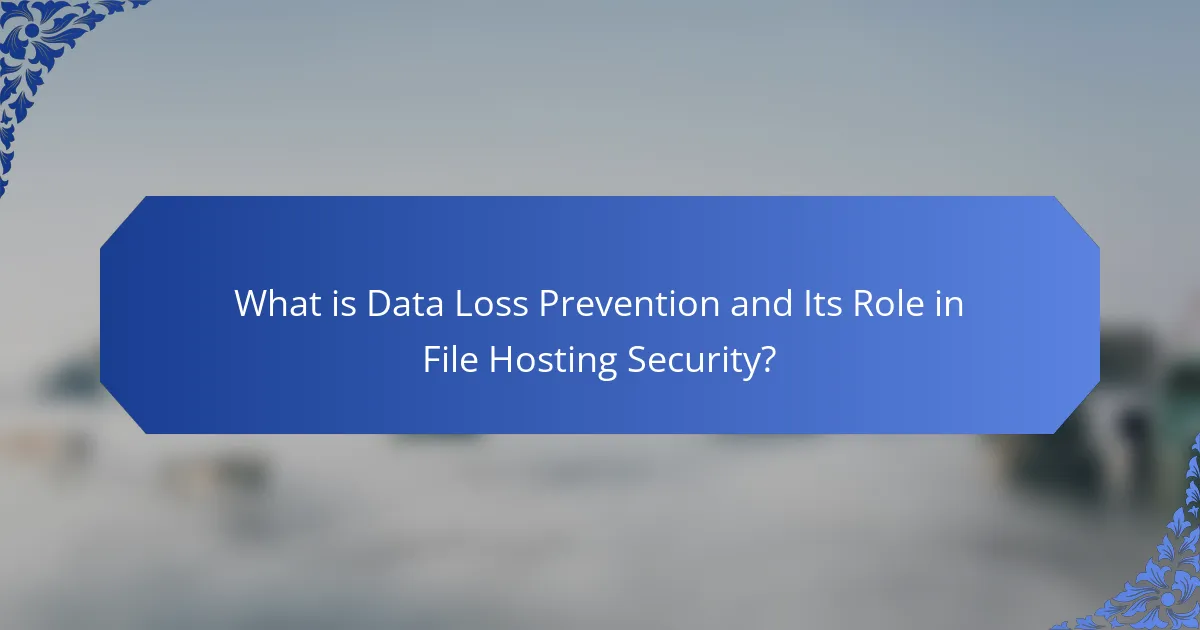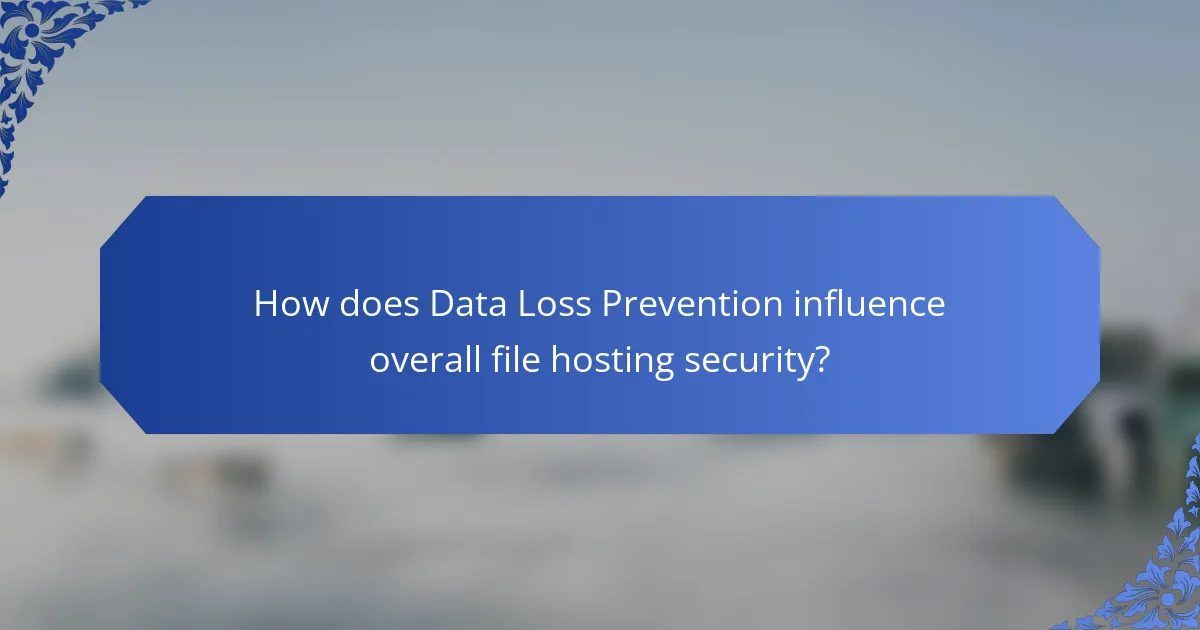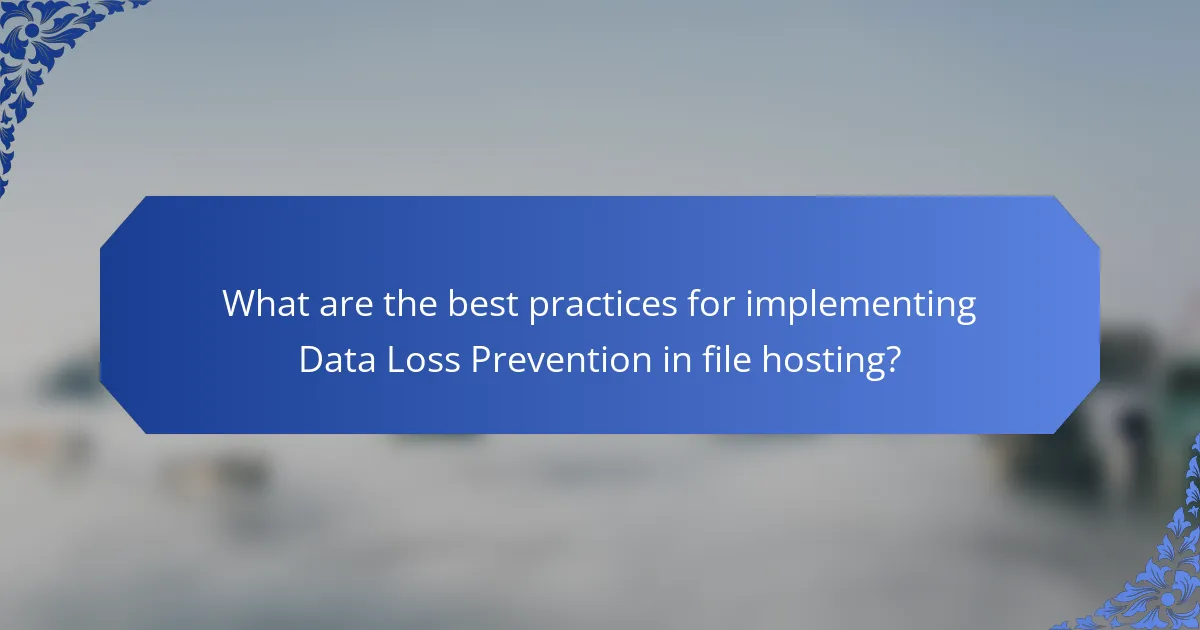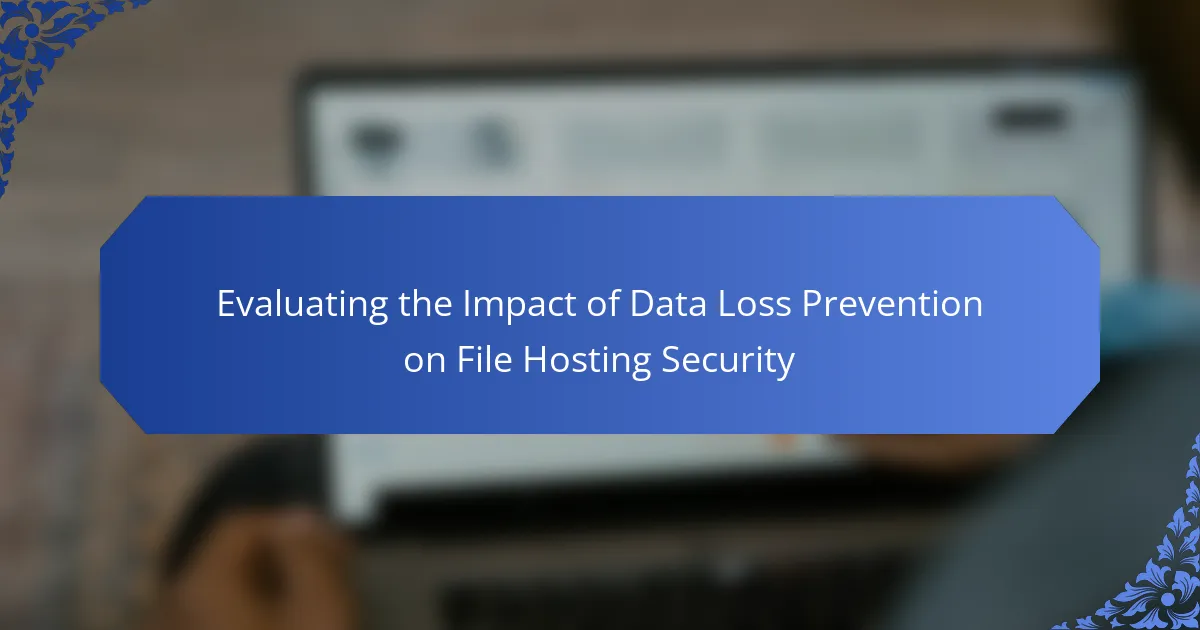Data Loss Prevention (DLP) is a critical strategy aimed at safeguarding sensitive information from unauthorized access and potential breaches in file hosting environments. This article evaluates the impact of DLP on file hosting security, highlighting its role in monitoring, detecting, and responding to data leaks. Key components include data classification, policy enforcement, and compliance with regulations such as GDPR and HIPAA. The discussion also emphasizes best practices for implementing DLP, including user training and integration with existing security frameworks, to enhance the overall security posture of organizations.

What is Data Loss Prevention and Its Role in File Hosting Security?
Data Loss Prevention (DLP) is a strategy designed to ensure that sensitive data is not lost, misused, or accessed by unauthorized users. DLP tools monitor, detect, and respond to potential data breaches or data exfiltration attempts. In file hosting security, DLP plays a critical role in protecting sensitive information stored on cloud platforms. It helps organizations comply with regulations by preventing unauthorized sharing of data. DLP solutions can classify data based on sensitivity and enforce policies to restrict access. For example, a DLP system may block the transfer of confidential files outside the organization. This proactive approach reduces the risk of data leaks and enhances overall security posture. According to a 2021 report by Cybersecurity Insiders, 68% of organizations experienced data loss incidents, highlighting the importance of DLP in mitigating risks.
How does Data Loss Prevention function within file hosting environments?
Data Loss Prevention (DLP) functions by monitoring and controlling data transfer within file hosting environments. DLP solutions analyze data at rest, in motion, and in use. They identify sensitive information based on predefined policies. When a policy violation occurs, DLP can block, encrypt, or alert administrators. This minimizes the risk of unauthorized access and data breaches. DLP tools often utilize machine learning to improve detection accuracy. According to a report by Gartner, organizations implementing DLP see a 30% reduction in data breaches. This demonstrates DLP’s effectiveness in enhancing file hosting security.
What are the key components of Data Loss Prevention systems?
The key components of Data Loss Prevention (DLP) systems include data discovery, data monitoring, and data protection. Data discovery identifies sensitive information across various locations. Data monitoring tracks the movement and usage of this information in real-time. Data protection enforces policies to prevent unauthorized access or transmission of sensitive data. These components work together to mitigate the risk of data breaches. According to Gartner, organizations that implement DLP systems can reduce data loss incidents by up to 75%.
How do these components interact with file hosting security measures?
Data loss prevention (DLP) components interact with file hosting security measures by providing an additional layer of protection. DLP systems monitor and control data transfers to prevent unauthorized access or sharing. They analyze file content and context to identify sensitive information. When integrated with file hosting services, DLP can enforce policies that restrict data sharing based on predefined criteria. This ensures that only authorized users can access sensitive files. Furthermore, DLP solutions can trigger alerts when potential security breaches occur. This proactive approach helps in mitigating risks associated with data loss. Studies show that organizations using DLP report a significant reduction in data breaches, enhancing overall file hosting security.
What are the primary objectives of implementing Data Loss Prevention?
The primary objectives of implementing Data Loss Prevention (DLP) are to protect sensitive data, ensure compliance with regulations, and prevent data breaches. DLP solutions identify, monitor, and secure data across various environments. They help organizations maintain data integrity by controlling access and usage. DLP also minimizes the risk of data leaks through unauthorized sharing or loss. Furthermore, compliance with laws such as GDPR and HIPAA is facilitated by DLP systems. These systems provide visibility and reporting capabilities to demonstrate adherence to regulations. Effective DLP implementation reduces the financial and reputational damage caused by data breaches. According to a 2021 report by Ponemon Institute, the average cost of a data breach was $4.24 million, highlighting the importance of DLP in mitigating such risks.
How does Data Loss Prevention protect sensitive information?
Data Loss Prevention (DLP) protects sensitive information by monitoring and controlling data transfers. DLP solutions identify sensitive data through predefined policies. They analyze data in transit, at rest, and in use. When sensitive information is detected, DLP can block, encrypt, or alert administrators. This minimizes the risk of unauthorized access or data breaches. According to a 2021 report by the Ponemon Institute, organizations using DLP experienced a 30% reduction in data loss incidents. DLP also ensures compliance with regulations like GDPR and HIPAA. By implementing DLP, organizations can secure sensitive information effectively.
What impact does Data Loss Prevention have on compliance with regulations?
Data Loss Prevention (DLP) significantly enhances compliance with regulations. DLP tools help organizations identify and protect sensitive data. They ensure that data handling aligns with legal requirements such as GDPR and HIPAA. By monitoring data transfers, DLP reduces the risk of unauthorized access. This proactive approach minimizes potential data breaches. Studies show that organizations implementing DLP experience fewer compliance violations. For example, a report by the Ponemon Institute found that DLP reduces the average cost of compliance failures. Overall, DLP is crucial for maintaining regulatory compliance in data management.

How does Data Loss Prevention influence overall file hosting security?
Data Loss Prevention (DLP) significantly enhances overall file hosting security by preventing unauthorized access and data breaches. DLP systems monitor, detect, and respond to potential data leaks in real-time. They enforce policies that restrict data sharing and transfer based on sensitivity levels. This minimizes risks associated with accidental or intentional data exposure. According to a 2021 report by Gartner, organizations implementing DLP saw a 30% reduction in data breach incidents. Moreover, DLP solutions provide detailed audits and reporting, allowing for better compliance with regulations such as GDPR and HIPAA. These features collectively strengthen the integrity and confidentiality of hosted files.
What are the potential risks of not using Data Loss Prevention?
Not using Data Loss Prevention (DLP) can lead to significant risks. One major risk is data breaches, where sensitive information is exposed to unauthorized individuals. According to a 2021 IBM report, the average cost of a data breach is $4.24 million. Without DLP, organizations lack the tools to monitor and protect against data exfiltration. This can result in regulatory fines, as non-compliance with data protection laws like GDPR can incur penalties up to 4% of annual revenue. Additionally, the absence of DLP can damage an organization’s reputation. Customers may lose trust if their data is compromised. Ultimately, not implementing DLP increases vulnerability to cyber threats and potential financial losses.
How can data breaches occur without Data Loss Prevention measures?
Data breaches can occur without Data Loss Prevention measures due to vulnerabilities in systems and human error. Systems may have unpatched software or weak security protocols. These weaknesses can be exploited by cybercriminals. Human error, such as sharing sensitive information unintentionally, also plays a significant role. Phishing attacks can trick users into revealing confidential data. Inadequate employee training increases the risk of such mistakes. According to the Verizon Data Breach Investigations Report, 22% of breaches involved human error in 2020. Without Data Loss Prevention measures, organizations lack the tools to monitor and control data access effectively. This increases the likelihood of unauthorized data exposure.
What are the consequences of data loss in file hosting?
Data loss in file hosting can lead to significant consequences. These include loss of critical business data, which can disrupt operations. It may result in financial losses due to recovery costs and potential legal liabilities. Additionally, data loss can damage a company’s reputation, leading to loss of customer trust. Organizations may face compliance issues, especially if sensitive information is compromised. According to a study by the Ponemon Institute, the average cost of data loss for businesses is around $3.86 million. This emphasizes the importance of implementing robust data loss prevention strategies in file hosting.
What benefits does Data Loss Prevention provide to file hosting services?
Data Loss Prevention (DLP) enhances file hosting services by protecting sensitive data from unauthorized access and breaches. DLP tools identify and monitor data, ensuring compliance with regulations like GDPR and HIPAA. They prevent data leaks by enforcing policies that restrict data sharing and transfer. Additionally, DLP solutions provide alerts for suspicious activities, enabling prompt responses to potential threats. A study by the Ponemon Institute found that organizations with DLP measures experienced a 50% reduction in data breaches. This underscores the effectiveness of DLP in safeguarding data integrity and confidentiality within file hosting environments.
How does Data Loss Prevention enhance user trust in file hosting platforms?
Data Loss Prevention (DLP) enhances user trust in file hosting platforms by safeguarding sensitive information. DLP solutions monitor, detect, and prevent unauthorized data access and sharing. They ensure that users’ files remain confidential and secure. This capability significantly reduces the risk of data breaches. According to a study by Ponemon Institute, companies with DLP strategies experience 45% fewer data breaches. Users feel more confident in platforms that prioritize data protection. Enhanced security measures directly correlate with increased user satisfaction and loyalty. Consequently, effective DLP implementation fosters a trustworthy environment for users.
What cost savings can be associated with implementing Data Loss Prevention?
Implementing Data Loss Prevention (DLP) can lead to significant cost savings for organizations. DLP reduces the risk of data breaches, which can save companies from the high costs associated with remediation and legal penalties. For instance, the average cost of a data breach is approximately $4.24 million, according to IBM’s 2021 Cost of a Data Breach Report. By preventing these breaches, organizations can avoid these substantial financial losses.
Additionally, DLP can minimize operational disruptions. When data breaches occur, businesses often face downtime that affects productivity. Preventing such incidents helps maintain seamless operations, leading to higher revenue retention. Furthermore, DLP can lower insurance premiums. Companies that demonstrate robust data protection measures may qualify for reduced rates on cybersecurity insurance.
Moreover, DLP streamlines compliance with regulations like GDPR and HIPAA. Non-compliance can result in hefty fines, which DLP can help mitigate. Thus, the proactive implementation of DLP not only protects sensitive data but also translates into tangible financial benefits.

What are the best practices for implementing Data Loss Prevention in file hosting?
Implementing Data Loss Prevention (DLP) in file hosting requires several best practices. First, organizations should classify data based on sensitivity. This helps in applying appropriate DLP measures. Next, establishing clear policies for data handling is essential. These policies should define what constitutes sensitive data and how it should be protected.
Regularly monitoring and auditing data access is also crucial. This ensures compliance with DLP policies and identifies potential vulnerabilities. Additionally, employing encryption for data at rest and in transit enhances security. Encryption protects sensitive information from unauthorized access.
User training on data protection practices is vital. Educated employees are less likely to inadvertently expose sensitive data. Finally, integrating DLP solutions with existing security infrastructure strengthens overall protection. This allows for a cohesive approach to data security.
These practices are supported by industry standards and frameworks, such as the NIST Cybersecurity Framework, which emphasizes the importance of data classification, monitoring, and user education in effective DLP implementation.
How can organizations assess their Data Loss Prevention needs?
Organizations can assess their Data Loss Prevention (DLP) needs by conducting a comprehensive risk assessment. This involves identifying sensitive data types and their locations within the organization. Organizations should evaluate potential threats to this data, including insider threats and external attacks. They must also assess current data protection measures and their effectiveness. Analyzing compliance requirements is crucial, as regulations often dictate specific data protection standards. Additionally, organizations should gather input from various stakeholders to understand different perspectives on data security. Finally, they can use DLP tools to monitor data flows and identify gaps in protection. This approach ensures that organizations tailor their DLP strategies to their unique needs and risks.
What factors should be considered when choosing a Data Loss Prevention solution?
When choosing a Data Loss Prevention (DLP) solution, factors such as data visibility, policy management, and user experience should be considered. Data visibility ensures that the DLP solution can identify and classify sensitive information effectively. Policy management evaluates the ease of creating and enforcing data protection policies. User experience assesses how the solution impacts end-users and their workflows. Integration capabilities with existing systems are also crucial for seamless operation. Compliance with regulations, such as GDPR or HIPAA, is necessary for legal adherence. Finally, scalability is important to accommodate future growth in data and user numbers.
How can organizations effectively integrate Data Loss Prevention with existing security protocols?
Organizations can effectively integrate Data Loss Prevention (DLP) with existing security protocols by aligning DLP policies with current security frameworks. This involves assessing existing protocols to identify overlaps and gaps. Organizations should ensure that DLP solutions complement firewalls, intrusion detection systems, and encryption methods. Implementing DLP training for employees enhances awareness of security practices. Regular audits of DLP configurations help maintain compliance with security standards. Integrating DLP into incident response plans ensures timely action against data breaches. Research shows that organizations with aligned DLP and security protocols reduce data loss incidents by up to 30%.
What common challenges do organizations face when implementing Data Loss Prevention?
Organizations face several common challenges when implementing Data Loss Prevention (DLP). One major challenge is the complexity of integration with existing systems. DLP solutions must work seamlessly with various software and hardware, which can be difficult. Another challenge is user resistance. Employees may feel that DLP measures infringe on their privacy and productivity. This can lead to non-compliance and ineffective implementation.
Additionally, organizations often struggle with defining sensitive data. Identifying what constitutes sensitive information can vary across departments. This inconsistency can hinder DLP effectiveness. Another challenge is the high cost associated with DLP solutions. Budget constraints can limit the ability to deploy comprehensive DLP strategies.
Furthermore, maintaining ongoing management and updates is crucial. DLP systems require regular monitoring and adjustments to adapt to new threats. Finally, organizations may face issues with false positives. Overly sensitive DLP systems can flag legitimate activities, causing operational disruptions. These challenges must be addressed to ensure successful DLP implementation.
How can organizations overcome resistance to Data Loss Prevention adoption?
Organizations can overcome resistance to Data Loss Prevention (DLP) adoption by implementing comprehensive training programs. Training increases awareness of data security risks and the importance of DLP. Engaging employees through workshops fosters a culture of security. Clear communication about DLP benefits reduces misconceptions. Involving staff in the DLP implementation process encourages buy-in. Providing ongoing support addresses concerns and eases transitions. Demonstrating success through case studies reinforces the value of DLP. According to a study by the Ponemon Institute, organizations with effective training see a 45% reduction in data breaches.
What strategies can help ensure successful Data Loss Prevention implementation?
Successful Data Loss Prevention (DLP) implementation requires a comprehensive strategy. First, organizations should conduct a thorough risk assessment to identify sensitive data and potential vulnerabilities. Next, establishing clear policies for data handling and protection is crucial. Training employees on these policies enhances compliance and awareness. Additionally, leveraging advanced DLP technologies can automate data monitoring and protection processes. Regular audits and updates to the DLP strategy ensure its effectiveness against evolving threats. According to a 2022 report by the Ponemon Institute, organizations with well-defined DLP strategies experience 40% fewer data breaches.
What are practical tips for maintaining effective Data Loss Prevention in file hosting?
Implementing strong access controls is essential for effective Data Loss Prevention (DLP) in file hosting. Limit user permissions to only what is necessary for their role. Regularly review and update access rights to ensure compliance.
Employ encryption for sensitive data both at rest and in transit. This adds a layer of security against unauthorized access. Utilize secure file transfer protocols to protect data during transmission.
Conduct regular audits and monitoring of file access and sharing activities. This helps identify potential data breaches or unauthorized access attempts promptly.
Train employees on DLP policies and best practices. Awareness can significantly reduce the risk of accidental data loss.
Implement a robust backup strategy to ensure data can be recovered in case of loss. Regular backups minimize the impact of data breaches or accidental deletions.
Utilize DLP software solutions that can automatically detect and prevent data leaks. These tools can enforce policies and alert administrators to potential threats.
Lastly, establish an incident response plan to address data loss situations effectively. A well-defined plan enables quick recovery and minimizes damage.
Data Loss Prevention (DLP) is a critical strategy for securing sensitive information in file hosting environments, aimed at preventing data breaches and unauthorized access. This article evaluates the role of DLP in enhancing file hosting security, detailing its functions, key components, and interaction with compliance regulations. It highlights the benefits of implementing DLP, including cost savings, improved user trust, and reduced data loss incidents. Additionally, the article addresses best practices for DLP implementation and the challenges organizations may face, providing practical tips for maintaining effective data protection.
